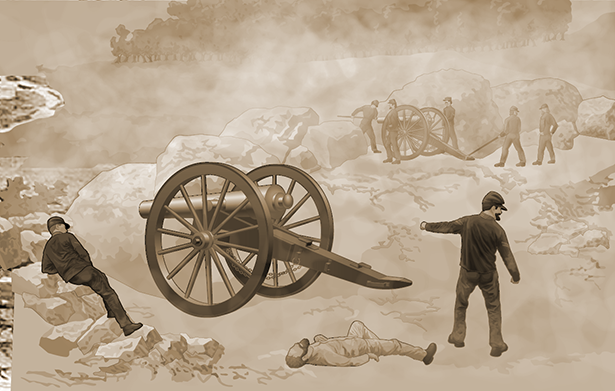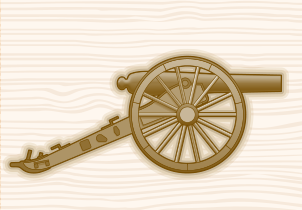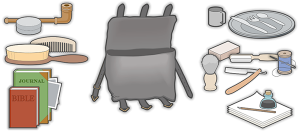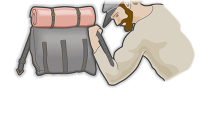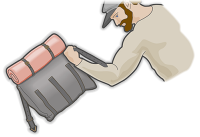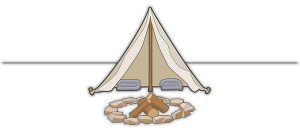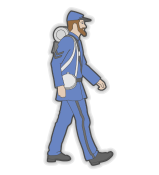
If we opened up all their haversacks and packs, and looked at what they were carrying, what would we find?
• Cartridge box and weapons
• Canteen (3 pints water)
• Rubber blanket,
• Woolen blanket
• Shelter tent
• Full winter clothing
• Tin cup, tin plate, knife, fork, spoon,
• Stationery
• Photographs, journal, Bible,
• Tobacco, pipes,
• Comb and brush,
• Shaving tools, sewing kit, toothbrush, soap
NEXT

Questions:
What does a backpacker on the Appalachian Trail carry today? What is similar or different about what they carry?
Why?
Sources for this information:
Busey, John W., and David G. Martin. Regimental Strengths and Losses at Gettysburg, 4th ed. Hightstown, NJ: Longstreet House, 2005.
The Battle of Gettysburg: Statistics
Soldiers' Life
START
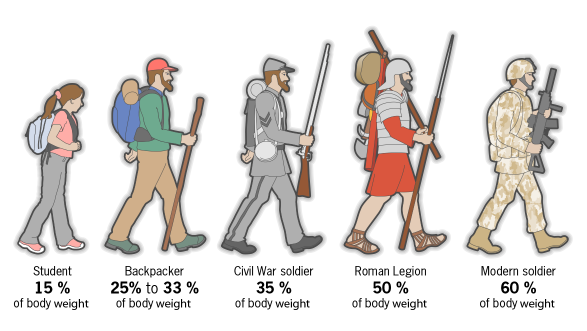
All together, it’s estimated that each soldier carried 44–50 pounds (Union soldier) and 30–80 pounds (Confederate soldier).
As a percentage of body weight that means that the average soldier (about 145 pounds) carried about 35% of his body weight on his back.
How does that stack up?
If you are a hiker, it’s estimated that your backpack should be between 25% and 33% of your body weight. If you are a student in school, it’s recommended that your backpack should only be 15% of your body weight.
But these were soldiers!
It’s estimated that Roman legionnaires carried 80 pounds or over 50% of their body weight! Modern day soldiers in conflicts such as Afghanistan carry over 100 pounds. They weigh an average of about 175 pounds, but that is still nearly 60% of body weight!
NEXT

Question:
What other factors might make it possible for today’s soldiers to carry so much more?
What about during Roman times?
Why do soldiers need to carry so much?
How else could the same goods be transported and what might be drawbacks of other means of transport?
START
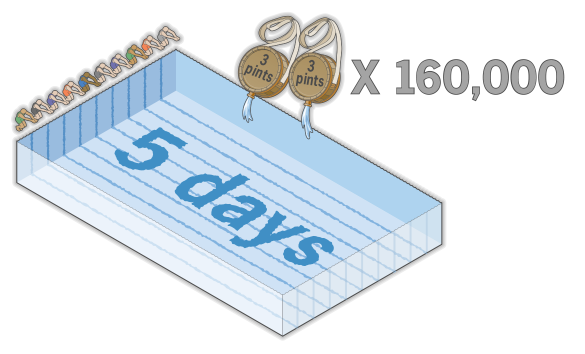
Considering the total equipment carried into the Battle of Gettysburg, we might expect to find:
160,000 canteens, each holding 3 pints of water.
A person weighing 145 pounds, engaged in vigorous exercise on a hot day should drink over 6 pints of water in one day. So each soldier would need to fill his canteen at least twice a day.
That means the soldiers need to locate a source for 960,000 pints of water, which translates into 480,000 quarts or 120,000 gallons.
An Olympic sized swimming pool holds about 660,000 gallons of water, so that would have supplied the soldiers for a little more than 5 days. But of course, there was no Olympic sized pool full of fresh drinking water available around Gettysburg PA in 1865! There were only small creeks and ponds.
NEXT

Questions:
How much water does your family use in a hot summer day?
What size container would it fill?
If you were in charge of an Army, would you plan for the water needs of your soldiers?
How?
Who else must plan for water needs?
START
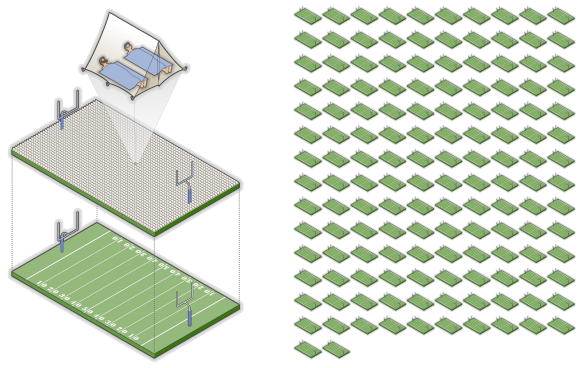
Each soldier carried a small tent with him, called a “dog tent.” It was actually just one panel of a tent that could be combined with another soldier’s panel, propped up on a tree branch, and used to shelter the two soldiers. Let’s assume two soldiers, sleeping side by side would take up about 36 square feet of space (six feet by six feet).
If all the soldiers put up their tents side by side and went to sleep, how much space would that take?
160,000 soldiers each occupying 36 square feet equals 5,760,000 square feet. There are 43,560 square feet in an acre which means about 132 acres of tents.
A football field is about the size of an acre. There are 640 acres in a square mile. So the tents all by themselves would take up 1/5 of a square mile! And that doesn’t include the horses, the supplies and all the other things that came with the soldiers!
NEXT

Questions:
How much area does your home (house or apartment) cover?
How does/did a military commander decide where to set up camp?
Is a military camp different today from Civil War times?
START
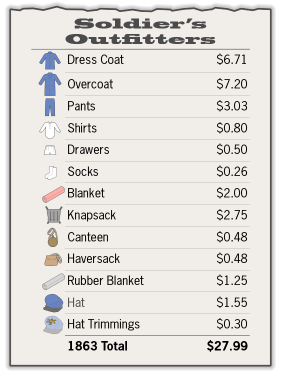
What did it cost to outfit a soldier?
One recruit noted that his equipment costs the following in 1860s dollars:
• Dress coat $6.71
• Over Coat $7.20
• Pants $3.03
• Shirts .88
• Drawers .50
• Socks .26
• Blanket $2.60
• Knap sack $2.75
• Canteen .48
• Haversack .48
• Rubber blanket $1.25
• Hat $1.55
• Trimmings on hat .30
1860 Total: $27.99
Adjusting for inflation, that’s about $394 in today’s money. If you were to outfit all the soldiers at the Battle of Gettysburg in today’s dollars, it would cost about $63,040,000.00!
NEXT

Questions:
Who paid the bill for Civil War soldier’s clothing and equipment?
Did the soldiers themselves have to buy all or part of it?
How des that compare to today’s U.S. military?
When and how have private citizens contributed or donated equipment to help soldiers?
What equipment do you believe should be supplied by the government, not the individual soldier?
START
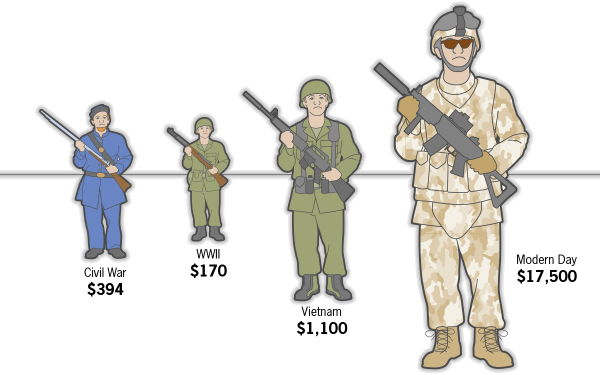
Today it costs about $17,500 to equip one soldier. In World War II it cost $170 per soldier. For the Vietnam War it cost $1100. (All are inflation-adjusted numbers).
Questions:
Why was the adjusted cost of equipping a Civil War soldier higher than the cost for a Word War II soldier?
Why so much more now?
What factors affect the costs of outfitting large armies?
Close x |
TeachersFirst.com ⋅ Thinking Teachers Teaching Thinkers® ⋅ Copyright © 1998-2024 by The Source for Learning, Inc. All rights reserved.


